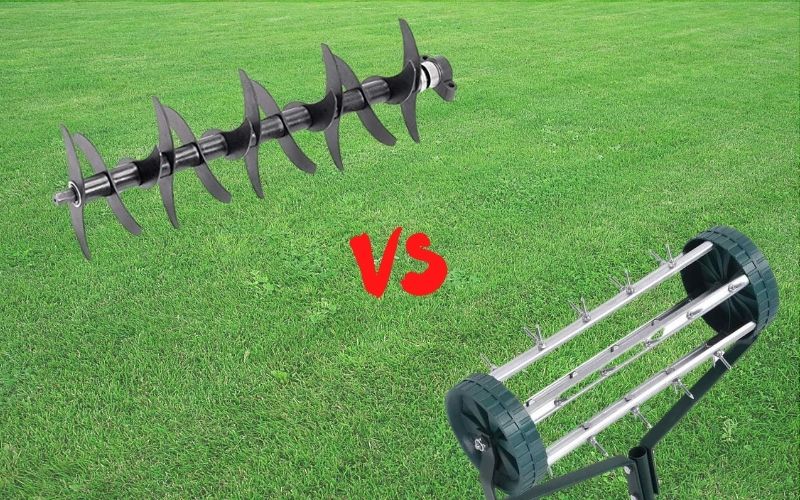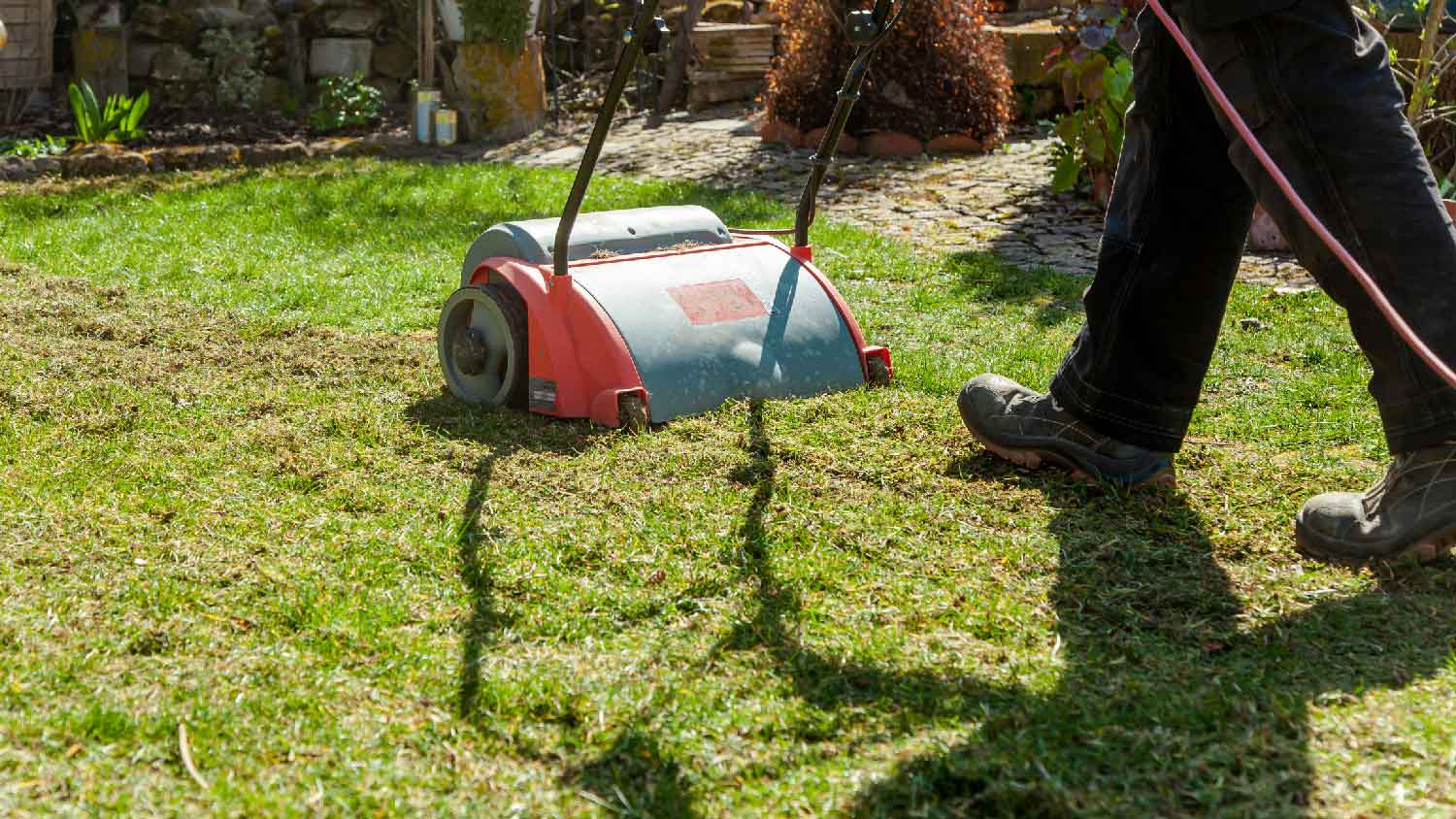If you consider your lawn your pride and joy, you probably know there’s more to the game than mowing. Both aerators and scarifiers can make a big difference when it comes to keeping your grass strong, green, and happy—but what’s the difference between these two tools?
An aerator, as its name suggests, penetrates into your soil to help bring air, moisture, and nutrients to your grassroots. Scarifiers, on the other hand, stay closer to the surface, working to remove the thatch that builds up between the growing surface of the grass and the soil below. Both are important components of a healthy lawn maintenance regime. Read on for more important details on scarifiers vs. aerators.
When it comes to lawn care, a scarifier and an aerator are two tools that are often confused with each other. However, while they both aim to improve the health of your lawn, a scarifier and an aerator actually perform quite different functions. Knowing the key differences between these tools will ensure you use the right one to treat your specific lawn care needs.
What is a Scarifier?
A scarifier, also known as a dethatcher, is a tool that removes thick layers of thatch from your lawn. Thatch refers to the dense mat of grass stems, clippings and roots that build up between the grass blades and soil surface over time.
Some thatch buildup can benefit your lawn by protecting grass roots and retaining moisture. However too much thatch will prevent water air and nutrients from reaching the soil and grass roots. It also causes poor drainage and encourages diseases and pests.
Scarifiers use blades or tines to cut through and lift up the thatch so it can be raked away. This rejuvenates your lawn by allowing sunlight, water and fertilizer to properly nourish the soil and roots underneath.
What is an Aerator?
Unlike a scarifier which targets surface thatch, an aerator works below the surface by poking holes into the soil Over time, lawn soil becomes compacted from foot traffic, mowing and other external pressures. Compacted soil prevents proper circulation of air, water and nutrients to the grass roots
An aerator uses hollow tines to punch through the compacted soil and extract plugs of dirt. The holes left behind enable better permeability so oxygen, water and nutrients can better reach the roots. Aerating relieves soil compaction and encourages healthier, denser turf.
Key Differences Between Scarifiers and Aerators
While scarifiers and aerators both aim to improve lawn health, they work at different levels and perform different functions:
-
Depth: Scarifiers work on the lawn’s surface to remove thatch while aerators penetrate 2-3 inches into the soil to puncture compaction.
-
Function: Scarifiers remove debris and thatch buildup while aerators poke holes to amend dense, compacted soil.
-
Benefits: Scarifying alleviates threats from excessive thatch while aerating facilitates circulation of air, water and nutrients to the roots.
-
Timing: Scarifying is needed at least once a year while aerating is typically only needed every 1-3 years.
-
Equipment: Scarifiers use blades to scrape up debris while aerators use hollow tines to extract soil plugs.
-
Use: Scarifiers directly remove material like thatch from your lawn while aerators simply poke holes without extracting anything.
When to Use a Scarifier vs. an Aerator
Because scarifiers and aerators perform different treatments, it’s important to determine which one is best suited to your specific lawn’s needs:
Use a scarifier if:
- There is excessive thatch buildup choking out the grass
- The lawn feels spongy underfoot due to thick thatch
- Puddles form on the surface and drainage is poor
- The grass appears yellow, thin or diseased
Use an aerator if:
- The lawn soil feels very compact and dense
- There is minimal thatch buildup
- The surface feels hard and lacks permeability
- Grass growth is stunted despite proper mowing, fertilizing, etc.
Many lawns will need both scarifying and aerating periodically to stay healthy. It’s best to alternate between the two treatments each year. Additionally, you may want to scarify first to remove debris, followed by aerating a few weeks later to amend the soil.
Manual vs. Powered Options
Both scarifiers and aerators come in manual and powered versions:
-
Manual: Handheld tools like rakes, harrows and spike rollers require more physical exertion.
-
Powered: Motorized units enable quick treatment of larger lawns with less effort.
Manual options provide an affordable alternative for smaller yards, while powered models are ideal for larger lawns. Renting is also an option if you don’t need regular treatments.
Improve Your Lawn’s Health
Knowing when to use a scarifier vs. an aerator ensures your lawn gets the right treatment it needs. While these tools perform different functions, they both improve lawn health by promoting circulation and alleviating compacted layers that choke out grass. Check your specific lawn care needs and add scarification or aerating to your maintenance routine.

Scarifier vs. Aerator: Differences in Function
Aerators and scarifiers are similar pieces of equipment in many ways, but they perform very different functions.
Lawn aeration is an important process that sounds a little silly at first. Basically, it means poking holes into the soil to help bring more air (and all the good things that come with it) under the surface.
Aerating your lawn combats the effects of soil compaction—which occurs when the dirt gets pressed harder and harder together over time thanks to factors like foot traffic. Plants can’t root well into tightly compacted soil, so aerating helps loosen it up, along with bringing light, oxygen, and nutrients to the roots of the grass.

Scarifying is more about what’s happening at the surface of the soil than below it. Between the live, green shoots that create the blanket of your lawn and the top of the soil that supports them, a layer of mostly dead plant material called thatch can build up. (Scarifiers are also sometimes called dethatchers.)
This is a natural process, and a little bit of thatch can even be good for a lawn, acting as a layer of insulation. Too much thatch, however, can suffocate your grassroots or trap water and rot. That’s why removing thatch from time to time is a helpful practice in cultivating a strong, healthy lawn—just as aerating is.Read more
Both aerators and scarifiers are available in a variety of different types and styles, each suited to specific needs and budget availability.
Manual aerators and scarifiers are those that are used by hand. They may be a type that you need to physically stamp into the earth, resembling a pitchfork, or one that can be pulled behind you or walked ahead, similar to a mechanical lawn mower. There are even aerator shoes, which are spiked attachments that strap onto the bottom of your shoes, making aerating your lawn as simple as walking across it.
Before we move on, it’s important to understand that there are two different types of aerators, specifically: Spike aerators and core aerators.
- Spike aerators are fitted with tines that press holes into the surface of the soil.
- Core aerators use hollowed-out cores to remove plugs of soil from beneath the grass, and are often considered a more efficient form of aerating. The cores can be allowed to disintegrate back into the soil beneath your lawn.
Scarifiers use blades, instead, to do the work of clearing thatch from under the surface of the grass. Keep in mind that most manual scarifiers do not have a collection box, so you’ll need to physically gather the scarified thatch afterward to dispose of it.
Aerators and scarifiers are also available in a motorized form, which looks a lot like a lawn mower with an engine. These are more expensive than manual equipment, and in the case of motorized core aerators, costs can top several thousand dollars. However, they’re a lot easier to use and more efficient than manual versions.
Both liquid aerators and liquid dethatchers are available: chemicals that can do some of the work of these mechanical tools. However, they tend not to work as well as physical aeration or dethatching, and may require several applications to perform at all, nullifying any cash savings they might offer.
While both manual scarifiers and aerators can be purchased at affordable prices, they are also both available in more expensive motorized versions. Still, motorized aerators are more expensive overall.
For example, a manual scarifier can be purchased for about $50, and certain types of manual aerators can be purchased for as little as $30. A motorized scarifier or dethatcher, however, can be purchased for about $150, while some types of motorized aerators cost several thousand dollars. (Both types of devices can also be rented, but given their very high price, aerators may make more sense to rent while scarifiers may make more sense to purchase.)
Aerator vs. Scarifier: What’s the Difference?
Photo: Kalim / Adobe Stock
As mentioned, an aerator is a tool that’s used to aerate—i.e., poke holes in—your lawn, while a scarifier is a tool that’s used to scarify—remove thatch from—your lawn.
Given the differences in their functions, these tools have different components in order to best perform their jobs.
| Type of Difference | Aerators | Scarifiers |
|---|---|---|
| Purpose | Penetrating soil | Removing thatch |
| Functional component | Spikes or cores | Blades |
| Types available | Manual, motorized | Manual,motorized |
| How often to use (generally) | Every 1–3 years | Yearly |
| When to use | Late summer to fall | Late spring to fall |
In order to truly understand the differences between these tools, we need to take a closer look at the specific functions they’re performing.Read more
Aeration vs Dethatching // Which should YOU do??
FAQ
Is it better to scarify or aerate your lawn?
If your lawn is plagued by a thick mat of dead grass and moss, it needs scarification/dethatching. If the soil underneath is hard as a rock, it needs aeration.Mar 26, 2025
Can you use a scarifier as an aerator?
A lawn scarifier or a lawn aerator? Both options are important to maintaining a healthy lawn and the good news is that machine tools are available that do both! At John Miller, our lawn scarifiers are also lawn aerators, which means that you can remove unwanted growth AND improve soil health with the same tool!
What is an alternative to a scarifier?
If you don’t have a scarifier, you can use a rake for scarification. There are actually many benefits to manually scarifying.
What is better for lawn dethatching or aerating?
If your lawn’s failure to thrive is due to compaction, you will want to aerate it. If thick thatch is the problem, you will instead need to dethatch your lawn.
